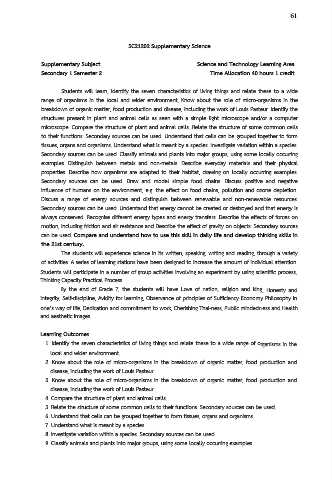Page 63 - เล่ม 65 ม.ต้น หลักสูตรสถานศึกษาโรงเรียนมงฟอร์ต
P. 63
61
SC21202 Supplementary Science
Supplementary Subject Science and Technology Learning Area
Secondary 1 Semester 2 Time Allocation 40 hours 1 credit
Students will learn, identify the seven characteristics of living things and relate these to a wide
range of organisms in the local and wider environment, Know about the role of micro-organisms in the
breakdown of organic matter, food production and disease, including the work of Louis Pasteur. Identify the
structures present in plant and animal cells as seen with a simple light microscope and/or a computer
microscope. Compare the structure of plant and animal cells. Relate the structure of some common cells
to their functions. Secondary sources can be used. Understand that cells can be grouped together to form
tissues, organs and organisms. Understand what is meant by a species. Investigate variation within a species.
Secondary sources can be used. Classify animals and plants into major groups, using some locally occurring
examples. Distinguish between metals and non-metals. Describe everyday materials and their physical
properties. Describe how organisms are adapted to their habitat, drawing on locally occurring examples.
Secondary sources can be used. Draw and model simple food chains. Discuss positive and negative
influence of humans on the environment, e.g. the effect on food chains, pollution and ozone depletion.
Discuss a range of energy sources and distinguish between renewable and non-renewable resources.
Secondary sources can be used. Understand that energy cannot be created or destroyed and that energy is
always conserved. Recognise different energy types and energy transfers. Describe the effects of forces on
motion, including friction and air resistance and Describe the effect of gravity on objects. Secondary sources
can be used. Compare and understand how to use this skill in daily life and develop thinking skills in
the 21st century.
The students will experience science in its written, speaking, writing and reading, through a variety
of activities .A series of learning stations have been designed to increase the amount of individual attention.
Students will participate in a number of group activities involving an experiment by using scientific process,
Thinking Capacity Practical Process
By the end of Grade 7, the students will have Love of nation, religion and king, Honesty and
integrity, Self-discipline, Avidity for learning, Observance of principles of Sufficiency Economy Philosophy in
one’s way of life, Dedication and commitment to work, Cherishing Thai-ness, Public mindedness and Health
and aesthetic images.
Learning Outcomes
1. Identify the seven characteristics of living things and relate these to a wide range of organisms in the
local and wider environment.
2. Know about the role of micro-organisms in the breakdown of organic matter, food production and
disease, including the work of Louis Pasteur.
3. Know about the role of micro-organisms in the breakdown of organic matter, food production and
disease, including the work of Louis Pasteur.
4. Compare the structure of plant and animal cells.
5. Relate the structure of some common cells to their functions. Secondary sources can be used.
6. Understand that cells can be grouped together to form tissues, organs and organisms.
7. Understand what is meant by a species.
8. Investigate variation within a species. Secondary sources can be used.
9. Classify animals and plants into major groups, using some locally occurring examples.

